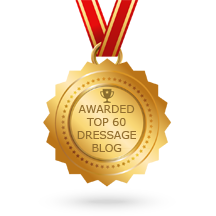[Guest Blog]: Horsemanship and Dressage
Nadja from www.beingwithorses.blogspot.de was so kind to help me out on a guest blog on the question of psychical readiness of the horse from a natural horsemanship standpoint of view. As you know, I am not a horsemanship expert but Nadja's input helps a lot to understand the principles. Thanks again to Nadja for letting me learn:
After Dressage Hafl‘s great guest post about horsemanship and dressage on beingwithorses, it‘s now my turn to give something back. I‘ve been wondering what horsemanship perspective might be useful for dressage riders.
As I probably can‘t tell you a lot about the physical training part, I will focus on two other categories that I find very important when being around and riding horses: the mental and emotional state of the horse. Just a few days ago I attended a presentation organized by the German Riding association and aiming to link the training practices of today with the riding tradition of the old masters. Well, I saw very talented horses and very talented riders - quite spectacular movements and maneuvers but not one horse was mentally with his rider. The animals were concerned about the surroundings, the hundreds of spectators. Meanwhile, the riders worked on collection, influencing the quality of their horses‘ movements: But while trying to shape the body they were neglecting the horses‘ mind.
The classic western horseman approaches it the other way round: Leslie Desmond (who worked with the Dorrance brothers, the fathers of the horsemanship movement) defines collection as the readiness of the horse to do something. He is alert and about to respond to a stimulus. Translated into my words that means that before the horse is able to give you the collected frame of his body, he needs to have his mind and emotions in place and sorted out. I will try to elaborate on that.
The mind: The horse is content with what the human asks him. He doesn‘t resent the human or the aids (meaning no pinned ears and no swishing tail) and he is willingly following the directions given. I am not talking about fear here, I am talking about the rider not having to fight to get the horse where he wants him and not having to discuss every single step because the horse has other things in mind (that he likes better than obeying orders). To not frustrate the horse, we need to set the communication up in a way that is
understandable and easy to execute. In the mind lives (and dies) motivation. And who does not dream of a motivated and eager horse?
The emotions: The horse needs to be in control of his emotions. When asking for collection, fear shouldn‘t be an issues anymore. If it is, I‘d recommend to forget the frame of the horse‘s body and deal with his emotions first (Warwick Schiller did a great video on control. You can find it here). It‘s hard for a prey animal to keep his head nicely at the perpendicular - limiting his view - when he assumes that he will be attacked by something lurking in the shade around the corner. He will try to lift his head to gain better view and focus on the danger instead of the rider‘s aids - and there goes the collection. The rider might be able to keep the head down in the shape he wants the neck in. But he will loose lightness, throughness and most importantly the horse‘s trust. There is no nice overriding the horse‘s sense of self preservation. Without relaxation no true collection exists.
The body: Do you know this saying „Watch your thoughts they become your words. Watch your words they become your actions. Watch your actions they become habits...“? Our actions are determined by our thoughts (and feelings). With horses, it‘s the same. Thoughts (or maybe impulses is the better word) and reactions are even linked closer as horses express where they are at without trying to conceal it as humans might. So we want to make sure that the horse is mentally and emotionally on our side, before we
try to bring his body in a certain shape. If we don‘t, we‘ll have a fight on the hand - with either a defiant or a scared horse.

Viewed from a horsemanship perspective, collection is the climax and goal of developing the horse and it encloses mind, emotions and body - each of which is equally important.
To close this guest blog, let me give you just one other spin. Christopher Dahlgren (Academic Art of Riding by Bent Branderup) checks the following prerequisites before he asks for collection: Is the horse relaxed, does he respond lightly and is he balanced. If all come together, the horse will offer roundness by himself. You can apply the mind-emotions-body filter here, too: Relaxation means the horse is in control of his emotions, and the lightness comes with the willing mind. Both give you mental balance of the horse. Physical balance comes with the right training. And all together will result in a collection - of the mind, the feelings and the body!
Nadja
www.beingwithorses.blogspot.de
Labels:
Guest Blogging


![[Guest Blog]: Horsemanship and Dressage](https://blogger.googleusercontent.com/img/b/R29vZ2xl/AVvXsEhJpMXajISWCjVdSNgw1mxA8MNZJl9kBMTKrhiKixmofo4ZAq5sa8K6tGiW-UGFdLhMSV47afSusig6X4dB-rjw6zO9ZhBL7qM5b2ROLZleELEHQcWOXgMvXvheUA8sYQkEm00T4b21ad8/s72-c/chillen.JPG)









No comments:
Post a Comment